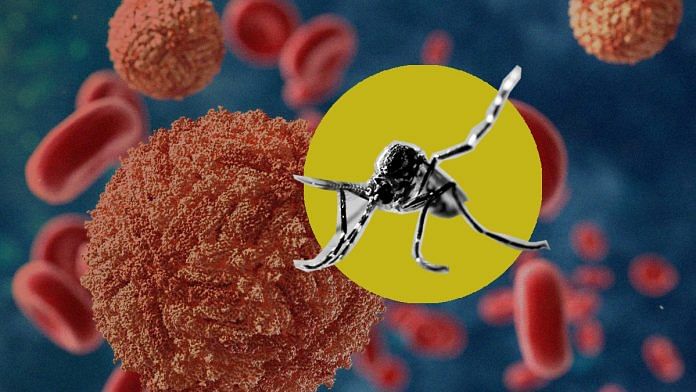Zika, dengue and chikungunya cases continue to be reported in India, all carried by the same mosquito. As mosquitoes grow immune to pesticides, scientists are considering genetically modifying them to combat diseases through either population suppression or elimination
ThePrint asks: Zika, dengue spreading— Should India invest in GM mosquitoes or make better pesticides?
Despite concerns, efforts to identify GM mosquitoes can be worthwhile pursuit
 Vishu Guttal
Vishu Guttal
Associate Professor of Ecology, IISC
GM studies must go beyond genetic and simple lab experiments. Ecological issues are rarely given much thought when we think of the safety and efficacy of GMs. There need to be studies on behavioural, population, and ecosystem consequences of interactions between species.
Assuming that the GM mosquito is safe both in the lab and during field trials, several ecological questions arise that need to be answered.
First, what happens to the ecology if mosquitoes disappear? From what we know, mosquitoes don’t really fulfil a special role that cannot be filled in by any other species – at least in urban settings. There are insects and birds that do feed on mosquitoes, but none we know that rely exclusively on them to survive. Thus, this doesn’t raise much concern.
Next, who takes up the ecological space if a mosquito species dies out and a new niche opens up? Is it possible that mosquitoes had been suppressing other dangerous vectors of diseases? This requires studies to be sure, but we can look at current studies that evaluate which species are dominant in areas of less mosquito density and high human density to make a safe guess. This hasn’t proven to be a concern.
Probably the main question is that of mosquito evolution itself. For short-lived insects like mosquitoes, evolutionary changes happen over hundreds of generations (i.e. a decade). Is it possible that over time, the female mosquitoes evolve to not mate with sterile males, making GMs less effective? That is something we might overcome with newer GMs. But what if some survivors undergo mutations proving to be more deadly than the original mosquito we tried to eliminate? Can they transmit more dangerous diseases than the current ones do? Such evolutionary aspects are not well studied or understood.
Despite all this, given the morbidity caused by mosquito-borne diseases, I believe that efforts to identify GM mosquitoes that control wild mosquito populations in urban settings are certainly a worthwhile pursuit.
Concerns of Indians will have to be taken into account before introducing GM mosquitoes
 Binoy Vijayan
Binoy Vijayan
Asst Professor of Animal Behaviour, NIAS
Many nations are testing the efficacy of releasing GM male Aedes egypti species for producing offspring which would die at an early stage and reduce the number of mosquitos in an area. The female mates only once and GM males competing with wild population of male for females will eventually crush local population. Other groups are trying to infect local mosquito population with a parasitic bacterium Wolbachia which decline population by hindering the maturation and hatching of the eggs.
The release of GM mosquitos into the environment and obliterating the local population raises ecological concerns. Every organism including mosquito has a role to play (‘niche’) in the ecosystem. When this evolutionary equilibrium is disturbed, the void generated will be occupied by another organism, sometimes a mosquito species. A biodiverse nation like India will have to design this kind of interventions very carefully that should not turn into a catalyst for the outbreak of another vector insect.
Due to their inability to reach adulthood, no permanent GM mosquito populations will exist. Hence, GM males will have to be released regularly into the wild. Similarly, the mosquito population has to be monitored constantly after releasing the Wolbachia-infected mosquitoes, loss of an infected population will have to be compensated. The efficacy of GM mosquitoes in geographically large and spatially complex landscapes like Indian cities has to be validated with a foolproof plan.
In India, if the public is not made aware of how GM mosquitoes work, resistance and controversy would erupt. Controlling mosquitos and the disease they spread is a very complex problem which cannot be attained without support from the society. The concerns of the people have to be taken into consideration while designing a policy for this.
There is no silver bullet. A multidimensional approach integrating various technologies and public involvement only can help mosquito-borne diseases in India.
GM mosquitoes are a bad idea for India
 P.K. Rajagopalan
P.K. Rajagopalan
Former director, Vector Control Research Centre, Pondicherry
GM mosquitoes are a bad idea for India. This idea to combat mosquito-borne diseases isn’t new. Even I have performed experiments in the 1970s. And since then, one main problem has persisted. The method requires genetic modification of males, not females. But it is extremely difficult to tell them apart and capture only males. There is no sexual dimorphism in the Aedes egypti mosquito that transmits zika.
This becomes a problem because females bite humans. We do not have enough studies about the risk and effects of this. Besides, these modified mosquitoes have to compete with wild mosquitoes that adapt quickly, so their efficiency, in general, will be low. We have to release a very large number of mosquitoes for there to be any effect. Even a 5 per cent contamination will be of great danger to humans.
An exorbitant amount of money and time will have to be spent on making this fully safe.
Another alternative people propose is improving vaccination, but at the moment, this is difficult. The yellow fever virus for the vaccine took 17 passages through generations to reduce virulence and develop antigenic properties. This again requires enormous amounts of time and money. Unfortunately, we have not been able to produce successful vaccines for diseases like dengue or chikungunya.
Our public health administrative machinery is so inefficient that the implementation is not done correctly.
Even pesticides are not always effective. Dengue mosquitoes breed in tree holes, but how many can we go spray?
The most practical way to go forward is environmental control. These are things like keeping drains covered and sleeping under nets that everybody knows of. These things should be reiterated again and again to make people aware and keep themselves safe.
GMs not different from plant and animal breeding methods that humans have always practiced
 L.S. Shashidhara
L.S. Shashidhara
Professor, genetics and developmental biology, IISER Pune
In evolutionary biology terms, this is a race between the host (human) and the pathogen (zika, dengue, chikungunya viruses) for survival. Genetic variations are generated every time an organism reproduces due to some alterations in DNA. If any of these variations provide the organism with an advantage for survival in changing environments, they would spread in the population within a few generations. As human generations take longer and we reproduce in smaller numbers, we generate fewer variations than viruses. Developing medicines and vaccines, therefore, take longer.
Furthermore, the mosquitoes that spread these viruses themselves are continually developing resistance to chemicals we deploy against them.
We need to re-examine the current methods of preventing infectious diseases. As the problem concerns the lives of a large number of people and may lead to massive deaths, we have to use modern technology to control the viruses and their carrier mosquitoes.
At the scientific level, GMs are not any different than plant and animal breeding methods that human societies have been practicing for more than 12,000 years. We have been transferring genes for desired traits using cross-breeding. A better understanding of biological systems has helped us to develop accelerated and safer methods of gene transfer.
India has 1.3 billion people with huge socio-economic diversity. As we delay using modern technology to address our health problems, the inequality within our country and between us and other developed countries goes up, making us forever dependent on other countries for even basic necessities like energy and nutrition.
GM mosquitoes and pesticides do same job at reducing population size
 Micheal Bonsall
Micheal Bonsall
Professor, St. Peters, Oxford and former science advisor to the House of Lords
Zika, dengue, West Nile virus and yellow fever are spread principally (but not exclusively) by Aedes egpyti mosquitoes. Female (but not male) mosquitoes bite and are blood-feeding. They require this meal to mature eggs before laying them in stagnant water.
How should we approach mosquito control?
Mathematical models of mosquito disease spread provide important predictions about how to control the disease. First, reducing mosquito bite rate is important and second, reducing mosquito population size below a threshold is critical to stop transmission.
Reducing bite rate is hard in Aedes mosquitoes; reducing population size is more achievable. GM mosquitoes are one approach (but not the only approach). Recent advances in genetic engineering have made male mosquitoes carry genes that kill the females before they reach adulthood. Fewer females mean the populations get smaller, the males can’t find mates, so the population gets even smaller. Eventually, both the modified and wild mosquitoes are gone.
So GM mosquitoes and pesticides do the same job at reducing population size but obviously combining them needs careful thinking as you don’t want to kill all those modified mosquitoes. Combining an initial pesticide spread with repeated GM mosquito releases might be economically viable but the environmental consequences of pesticide use can’t be overlooked – so lots more research thinking is needed here.
How about vaccines? Vaccines need to be fully efficacious against the disease – partial immunity can cause individual complications and limit effective coverage. Again combining vaccines and GM mosquitoes to work in tandem needs more research so that the full potential of all the tools against devastating infectious diseases such as zika can be thoroughly achieved.
Only way to combat menace is combine all options: Pesticides, environmental control, GM
 Sandhya Ramesh
Sandhya Ramesh
Senior Assistant Editor, Science, ThePrint
It isn’t black and white, and one doesn’t deserve more importance at the other. Pesky mosquitoes have haunted us for centuries in tropical climates, and are even credited to poverty in several developing nations. Just a handful of mosquitoes can cause a deadly outbreak of a disease, so it’s important to curb their population.
The problem with mosquito control has always been that one single method doesn’t work. Mosquitoes tend to evolve quickly. DDT was a great boon until insects started developing a resistance to it. All pesticides that are used for mosquito control need to keep changing as mosquitoes breed rapidly and start genetically modifying themselves.
Environmental and personal care taken by individuals play a huge role. We learned during our school days how to protect ourselves from malaria: use mosquito nets, close windows at dusk, use mosquito repellant, etc.
As more technology becomes available to us, it seems almost careless to not make use of it to better our health. GM mosquitoes show a lot of promise. Even if we leave implications of a gene drive and species elimination aside, controlling the population through male sterility seems to be a viable solution that can be added to the mix. As GM mosquitoes will be competing with wild males, it will never come to a point where they outnumber non-GM mosquitoes.
However, prioritising GM mosquito research and trials shouldn’t be at the cost of bettering existing methods to make them more efficient, especially when it’s expensive. The technology is new, so cooperation and consent from citizens in field trials will be required.
The only way to combat this menace is to do a careful combination of everything available to us: pesticide, environmental control through awareness, vaccines, and also, in the future, GM.
By Sandhya Ramesh, associate editor at ThePrint.



